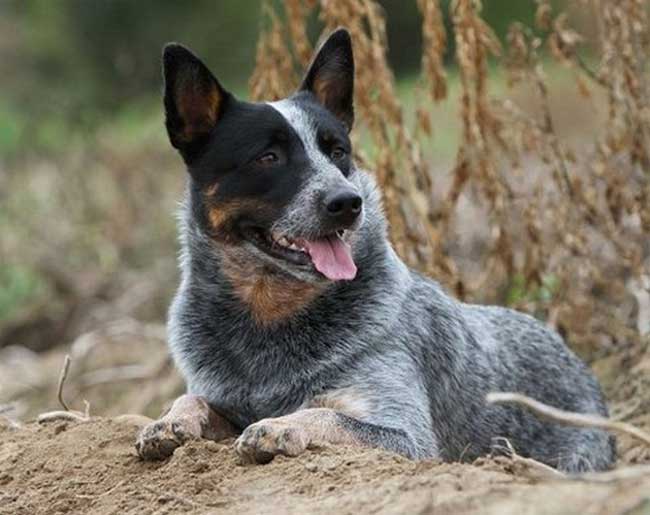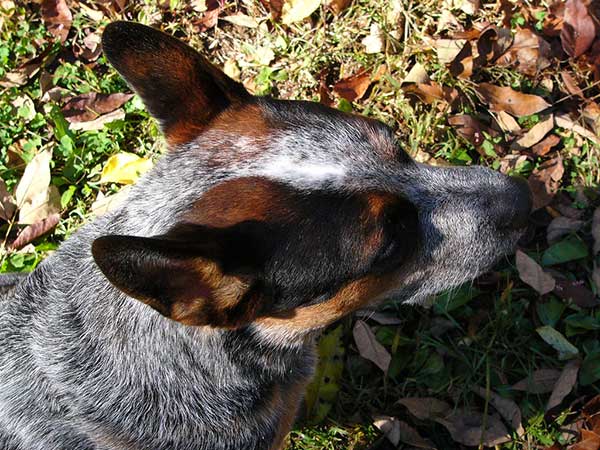Some dog breeds change their coat color during their life. If you are a Blue Heeler owner, you may wonder if your pet belongs to this group.
Besides, when do Blue Heeler puppies get their color? So, to answer all of your questions, we have gathered valuable information in this post.
Let’s scroll down to discover!
What Color Are Newborn Blue Heelers?
It’s surprising that Blue Heelers are born with an all-white coat. This characteristic is also most likely a consequence of their Dalmatian origin.
These pups may come with brown patterns on their legs and chest, white spots with patterns, and black marks over their eyes.
Blue Heelers and Red Heelers, two species of Australian Cattle Dogs, are white when born, except for a few patches of solid color. The puppies’ black or red hairs appear as they age.

1. Newborn Blue Heelers are white
When Do Blue Heeler Puppies Get Their Color?
By the time they are around four weeks old, Blue Heelers start to change from their birth hue of white to various blue shades. Also, they will soon grow a distinctive fur coat with patches of different colors on their legs and head.
A single or double black spot may cover one or sometimes both eyes in some Blue Heelers. By the time they are six or seven weeks old, their coloration will become more clearly defined.
Then, at around 12 weeks old, they start to shed their fluffy, velvety puppy coat. Their coat color may change once again during this period.
When the white hairs gradually disappear, they will begin to turn an even deeper shade. Their coats will stop changing between the ages of 14 and 24 months.
No matter which color Blue Heelers turn into, they often have two coat types, the mottled and the speckled, contributing to their coat uniqueness.

2. The dogs change their coat color gradually
How Many Coat Designs On Blue Heeler?
Mottled and speckled coats are the two main coat designs in Blue Heelers. They both have a black base, but the patches make them different.
Mottled Coat
Regarding coat varieties with mottled coats, they have tiny, lighter-colored markings that resemble leopard spots over the black color. Most Blue Heelers’ dots range from light blue to silver blue.
Pure breeds may have their heads evenly spaced with black, blue, or brown patches. Some species have black spots on their eyes.
Speckled Coat
Black is the base color of speckled coats. You also notice white hairs popping out on the black background, giving an effect of a blue color.
Blue Heelers with more white hairs have a lighter blue color. On the other hand, the ones with fewer white patches will look darker.
What Are The Other Colors Of Blue Heeler Coats?
The Blue Heeler’s coat is black at its base. The white hairs appear all throughout, giving the impression of bluish.
However, the exact color of a grown Australian Cattle Dog differs depending on the genes that they inherit, like the trait of Mutt Mixer:
- Ticking genes decide if the Australian Cattle Dog will grow to be blue or red. Hence, we have Blue Heelers and Red Heelers.
- Agouti genes determine the patches on the dog’s face.
- Spotting genes influence the white spots on the dog’s body.
Does The Mottled Or Speckled Blue Heeler Cost More?
Both coat designs are common. As a result, their prices will be pretty similar.
The price of either one or the other might change according to other factors, such as breeding, health, age, or personality.
The genuine hue is one factor that affects the pricing. At night, the darker blue is less visible, making it more appealing for particular uses, and it can be beneficial while working outside.
Some members of this breed have a distinctive white-haired mark or star on their forehead. We call it “Bentley Mark/Star.”
People think that dogs with those markings were descendants of an Australian Cattle Dog that Thomas Bentley owned and raised. This marking may increase the cost of a dog.

3. Dogs with a Bentley mark cost more
The Meaning Behind The Color
Color-changing is a notable characteristic of Blue Heelers. Once mature, they turn a lot darker compared to their born color. Meanwhile, their tail remains in a light hue. So what do these colors mean to the dogs?
Dark coats
When stockmen adopt this species to help them care for cattle, the transition to a darker shade has a practical purpose. It can blend in the surroundings and become unnoticed so that the dogs won’t spook the cattle.
As a result, Blue Heelers can look after the livestock easily. Moreover, the cattle won’t even know that the dogs are watching them. Hence, they won’t get surprised and accidentally injure themselves.
Light-colored tails
The stockman can more easily locate their dog’s exact position at night because of the tail’s light-colored hair.
Conclusion
Blue Heelers have a white color when born. However, their fur coats will darken to black once they reach the fourth week. There are some white patches on their body, establishing a bluish effect.
We have shared with you everything about a Blue Heeler’s coat color. If you need any further information, please feel free to ask.
Related posts: